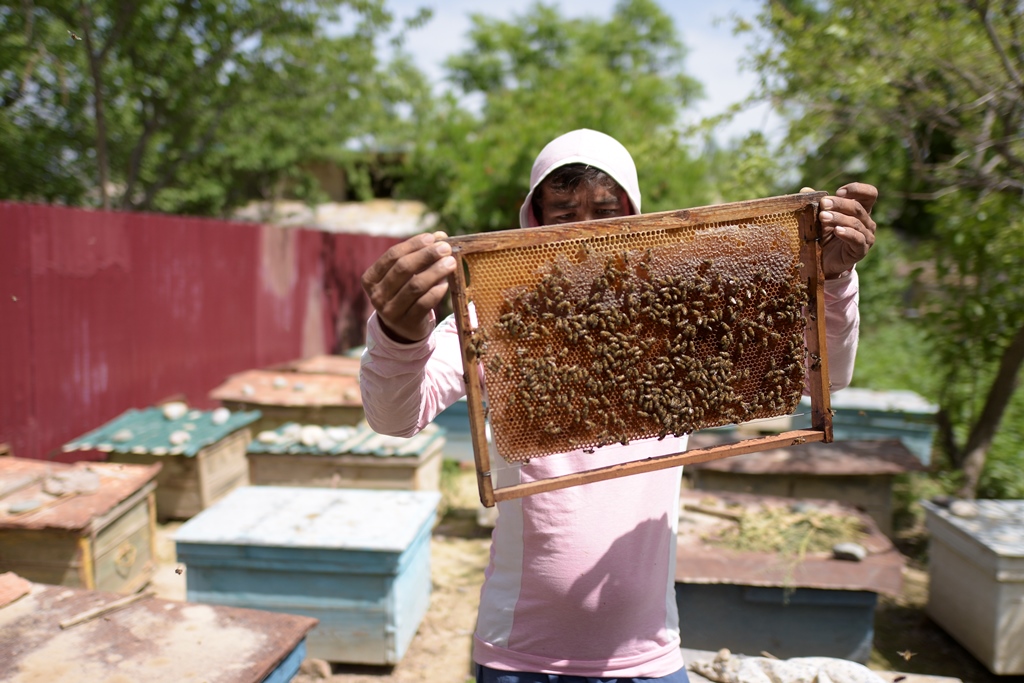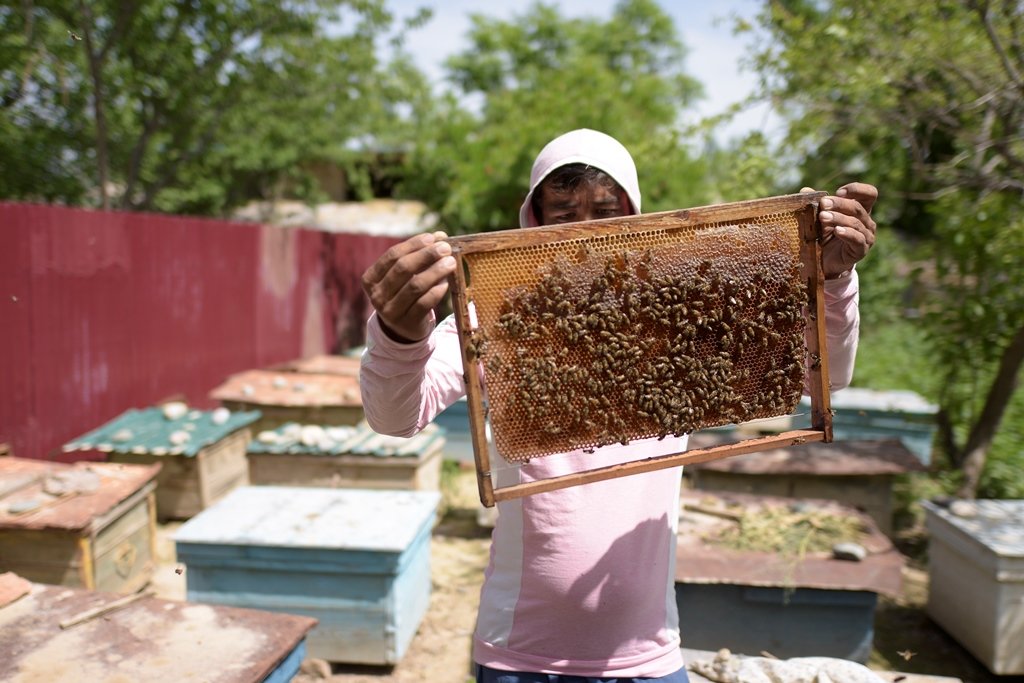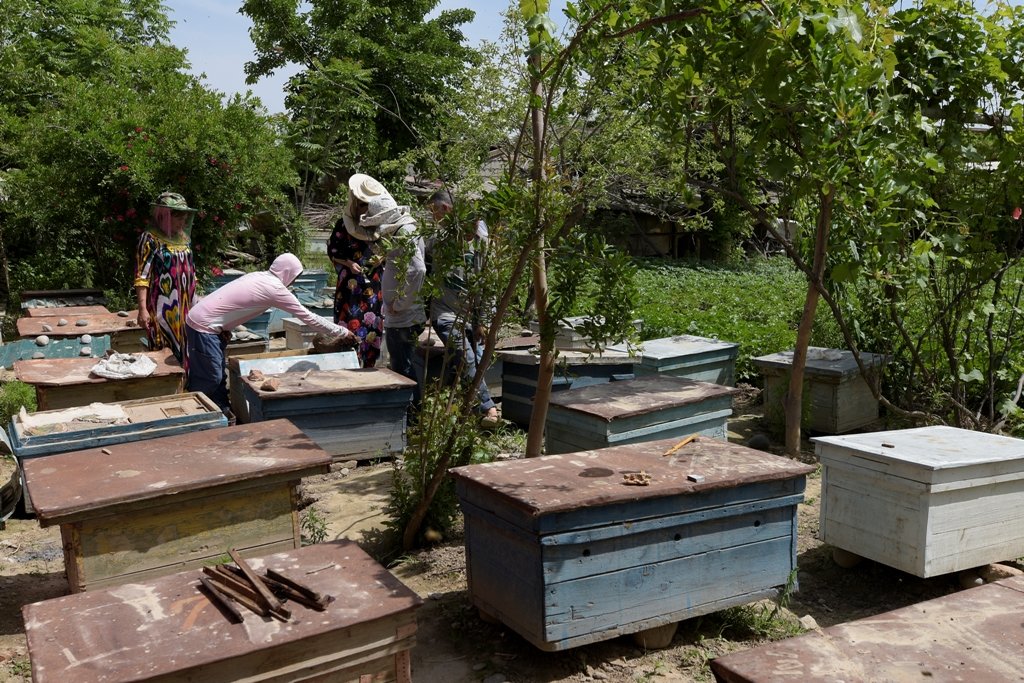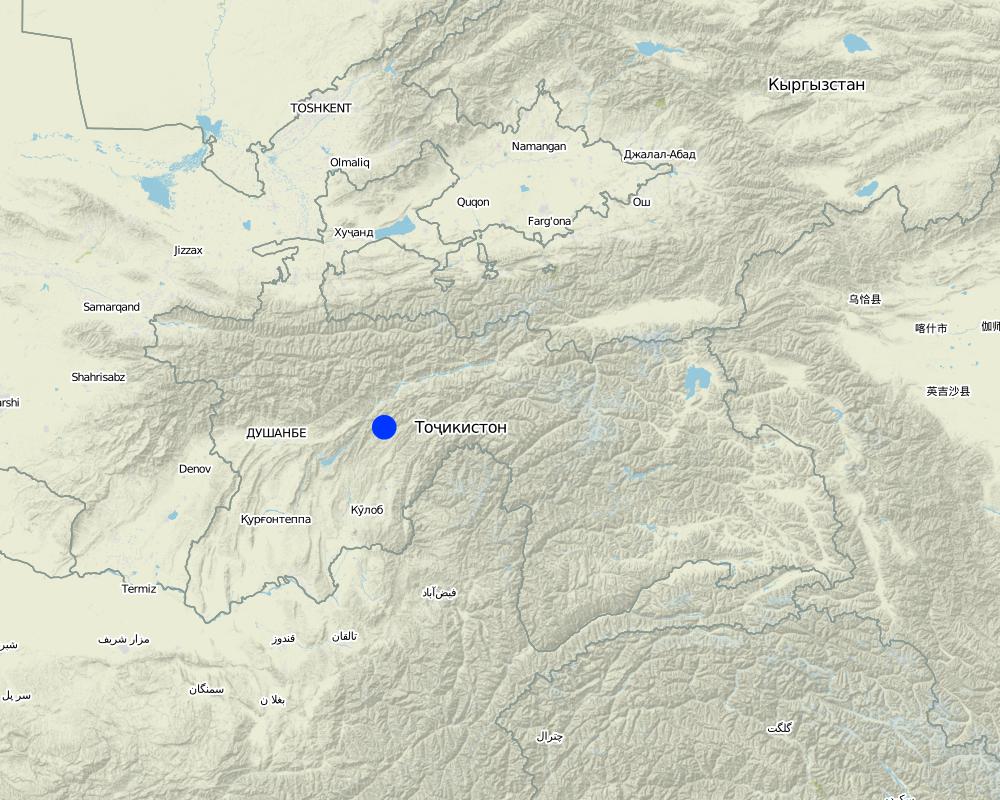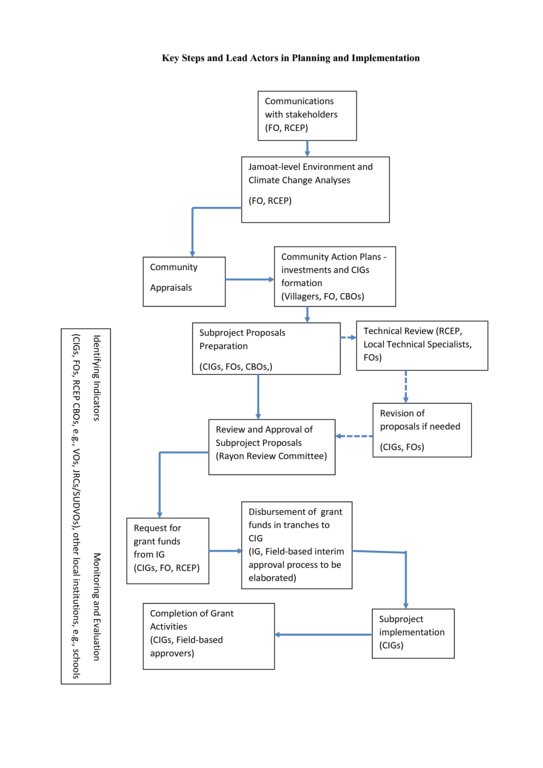Improving productivity of fruit trees through development beekeeping sector [ทาจิกิสถาน]
- ผู้สร้างสรรค์:
- การอัพเดท:
- ผู้รวบรวม: Kamolidin Abdulloev
- ผู้เรียบเรียง: –
- ผู้ตรวจสอบ: Farrukh Nazarmavloev
Бехтар намудани самарраи дарахтони мевадиханда таввасути занбурпарвари
approaches_3887 - ทาจิกิสถาน
ดูส่วนย่อย
ขยายทั้งหมด ย่อทั้งหมด1. ข้อมูลทั่วไป
1.2 รายละเอียดที่ติดต่อได้ของผู้รวบรวมและองค์กรที่เกี่ยวข้องในการประเมินและการจัดเตรียมทำเอกสารของแนวทาง
วิทยากรหลัก
ผู้เชี่ยวชาญ SLM:
ชื่อของโครงการซึ่งอำนวยความสะดวกในการทำเอกสารหรือการประเมินแนวทาง (ถ้าเกี่ยวข้อง)
Environmental Land Management and Rural Livelihoods (ELMAR)ชื่อของโครงการซึ่งอำนวยความสะดวกในการทำเอกสารหรือการประเมินแนวทาง (ถ้าเกี่ยวข้อง)
Committee for Environment Protection of Tajikistan (Committee for Environment Protection of Tajikistan) - ทาจิกิสถาน1.3 เงื่อนไขที่เกี่ยวข้องกับการใช้ข้อมูลที่ได้บันทึกไว้ผ่านทาง WOCAT
วันที่เก็บรวบรวมข้อมูล (ภาคสนาม):
22/06/2018
ผู้รวบรวมและวิทยากรหลักยอมรับเงื่อนไขเกี่ยวกับการใช้ข้อมูลที่ถูกบันทึกผ่านทาง WOCAT:
ใช่
2. คำอธิบายของแนวทาง SLM
2.1 การอธิบายแบบสั้น ๆ ของแนวทาง
Honeybee keeping improves pollination of trees, shrubs, and crops, which will increase the productivity of orchards, arable lands, grassland
2.2 การอธิบายอย่างละเอียดของแนวทาง
การอธิบายอย่างละเอียดของแนวทาง:
Beekeeping provides an opportunity to improve the economic use and ecosystem sanitation in the future. On the one hand, honeybee keeping improves pollination of trees, shrubs and crops, which will increase the productivity of orchards, arable lands, grassland and highland areas also households got high-quality honey and income. In addition, an approach is supporting households using the existing natural features, population improved their living standards by increasing the production of environmentally sound and high-quality honey, then sold at local markets.
Shaidon village has 238 households and 1651 people are living. Shaidon village is located at a distance of 35 km from the district center. According to statistics, the area of land used in the village is 886 hectares. Of these, 60 hectares are household plots, 26 hectares are private farms and 800 hectares occupy pastures. The population is engaged in breeding 470 heads of neat cattle, 520 heads of small cattle, 5 horses, 120 donkeys, 460 chickens and 60 turkeys. On average, each household has 0.08 ha of plots. The soil in the village is included in the category of gray soil. The annual rainfall in the village is up to 700 mm. Winter lasts for 3 months. The terrain is flat, the source of drinking water is groundwater and natural water resources.
An approach supported on behalf of the ELMARL Project. Shaidon village has expanded and favorable opportunities for the development of the beekeeping sector. and bee families were provided to 25 households that are the CIG members. And the CIG members considers that it necessary to strengthen the productivity of fruit trees in the village, through the development of beekeeping sector, as the result provided bee colonies (hives), appropriate uniforms and supplies, wax and medicines, so that ensure the production of ecologically pure honey, the appearance of additional income and new working places. Farmers have purchased the following units under the Project: 25 hives, 25 bee colonies, 1 pc. smothe king device, 1 pc. special device for collecting honey, 15 pcs. protective clothing, 150 kg of sugar and medicines the purchase of which as well transportation of hives and bee families from Khatlon region were funded by the Project. Arrangement, moving and care of bees is assigned to the farmers.
2.3 รูปภาพของแนวทาง
ข้อสังเกตทั่วไปเกี่ยวกับรูปภาพ:
Shaidon village has expanded and favorable opportunities for the development of the beekeeping sector
2.5 ประเทศ ภูมิภาค หรือสถานที่ตั้งที่ได้นำแนวทางไปใช้
ประเทศ:
ทาจิกิสถาน
ภูมิภาค/รัฐ/จังหวัด: :
Kulob Region, Baljuvon District
ข้อมูลเฉพาะเพิ่มเติมของสถานที่ตั้ง:
Sari Khosor jamoat, Shaidon village
ความคิดเห็น:
The approach will be implemented in the Shaidon village
Map
×2.6 วันที่เริ่มต้นและสิ้นสุดของแนวทาง
ระบุปีที่เริ่ม:
2016
การสิ้นสุดลง (ถ้าแนวทางไม่ได้ใช้อีกต่อไป):
2017
ความคิดเห็น:
This approach has been implemented on a project base and during the 2 years monitored and controlled. The CIG gives this responsibility and will manage and maintain it in future
2.7 ประเภทของแนวทาง
- ใช้โครงงานหรือแผนงานเป็นฐาน
2.8 เป้าหมายหรือวัตถุประสงค์หลักของแนวทาง
Enhancing productivity of the orchards, arable lands, grassland and highland areas and improve the economic use and ecosystem sanitation in the future by developing beekeeping
2.9 เงื่อนไขที่เอื้ออำนวยหรือเป็นอุปสรรคต่อการนำเทคโนโลยีภายใต้แนวทางนี้ไปปฏิบัติใช้
บรรทัดฐานและค่านิยมทางสังคม วัฒนธรรม ศาสนา
- เอื้ออำนวย
Before the project people besides the income did not think about the other issues like environment and productiveness of the orchards and agriculture lands
Proposed approach change their minds to think broader, through supporting them with the training and also beekeeping equipment
การมีไว้ให้หรือการเข้าถึงแหล่งการเงินและบริการ
- เอื้ออำนวย
For now not
But in the near future, they will have the opportunity for the availability of the income, as the group trying to increase the number of the beehives.
การจัดตั้งระดับองค์กร
- เอื้ออำนวย
The CIG group is formed and will manage and maintain the approach
ความรู้เกี่ยวกับ SLM การเข้าถึงการสนับสนุนด้านเทคนิค
- เป็นอุปสรรค
Lack of knowledge on SLM approaches and technologies
Organised and provided the different type of SLM relative trainings on behalf of the project but iy is steel an issue
3. การมีส่วนร่วมและบทบาทของผู้มีส่วนได้ส่วนเสียที่เกี่ยวข้อง
3.1 ผู้มีส่วนได้ส่วนเสียที่เกี่ยวข้องในแนวทางนี้และบทบาท
- ผู้ใช้ที่ดินระดับท้องถิ่นหรือชุมชนระดับท้องถิ่น
CIG members (local farmers)
Local farmers prioritized investments based on a fixed budget for each type of rural investment determined by the number of households. Within a plan of action, participants decided on the allocation of investments to groups of households using rules that limit the funding for any one household.
All activities, including PRA, training and investment subprojects involved men and women with due a diligence. Social safety was assured for the people with disabilities, who participated in rural livelihoods activities and had equal rights and voices.
- ผู้เชี่ยวชาญ SLM หรือที่ปรึกษาการเกษตร
Facilitating organizations and academy of science
Representatives from the facilitating organizations and professors (as TOT trainers) from the Institutions and academies involved during the training
- รัฐบาลระดับท้องถิ่น
Jamoat representative, Hukumat of the district departments
Jamoat representatives were involved in Participatory Rural Appraisal (PRA) that was used as the main pre-assessment mechanism to analyze the socio-economic and environmental situation in the selected pilots,
The RRC(Rayon Review Committee) will consider the combination of proposed sub-projects within the overall context of the rayon and project. The committee will review and accept proposals that meet project guidelines and provide clearance to the Project Staff for the release of project funding to the accounts of relevant CIGs.
3.2 การเกี่ยวข้องของผู้ใช้ที่ดินระดับท้องถิ่นหรือชุมชนระดับท้องถิ่นในช่วงต่างๆของแนวทาง
| ความเกี่ยวข้องของผู้ใช้ที่ดินระดับท้องถิ่นหรือชุมชนระดับท้องถิ่น | ระบุผู้ที่มีส่วนเกี่ยวข้องและอธิบายกิจกรรม | |
|---|---|---|
| การวางแผน | ไม่ลงมือ | Project beneficiaries (CIG Members) interviewed and consulted during the social assessment conducted in the project design process which then influenced project approaches. |
| การดำเนินการ | ปฏิสัมพันธ์ | Villagers (CIG Members) made grant allocation decisions. CIGs managed grant funds and purchased needed materials and products individually |
| การติดตามตรวจสอบหรือการประเมินผล | ไม่ลงมือ | CIGs participated during the monitoring activity |
3.3 แผนผังแสดงขั้นตอนการทำงาน (ถ้ามี)
คำอธิบาย:
Here is the key steps and actors in the planning and implementation of rural investments. Not all possible participants in these steps are included since local situations may vary and will need to be taken into account during planning and implementation.
ผู้เขียน:
ELMARL POM
3.4 การตัดสินใจเลือกใช้เทคโนโลยี SLM
ระบุผู้ที่ทำการตัดสินใจเลือกเทคโนโลยีมากกว่าหนึ่งวิธีไปปฏิบัติใช้:
- ผู้ใช้ที่ดินเป็นผู้ตัดสินใจหลัก โดยการสนับสนุนจากผู้เชี่ยวชาญ SLM
การอธิบาย:
Villagers prioritized investments based on a fixed budget for each type of rural investment determined by the number of households. Within a plan of action, participants decided on the allocation of investments to groups of households (Common Interest Groups, CIGs) using rules that limit the funding for any one household.
ระบุว่าการตัดสินใจตั้งอยู่บนพื้นฐานของ:
- การประเมินความรู้ SLM ที่ได้ทำการบันทึกไว้เป็นอย่างดี (การใช้ข้อมูลในการตัดสินใจ)
4. การสนับสนุนด้านเทคนิค การสร้างขีดความสามารถ และการจัดการด้านความรู้
4.1 การสร้างขีดความสามารถ / การอบรม
ได้มีการจัดอบรมให้แก่ผู้ใช้ที่ดินหรือผู้มีส่วนได้ส่วนเสียคนอื่น ๆ หรือไม่:
ใช่
ให้ระบุว่าใครเป็นผู้ได้รับการอบรม:
- ผู้ใช้ที่ดิน
- เจ้าหน้าที่ภาคสนาม / ที่ปรึกษา
ถ้าเกี่ยวข้อง ให้ระบุ เพศ อายุ สถานภาพ ชาติพันธุ์ เป็นต้น:
Specialists from the FOs used mechanisms that provided full participation, women, and men in all sessions
รูปแบบการอบรม:
- กำลังดำเนินการ
- เกษตรกรกับเกษตรกร
หัวข้อที่พูด:
Grant allocation mechanisms. Fund flow arrangements, management and technical, SLM training
ความคิดเห็น:
Training included such king themes;
composting, mulching, managing salinization, intercropping on slopes, drip irrigation, low-cost watering techniques, solar greenhouses, drought-resistant crops, bee-keeping, mixed fruit orchards, local varieties nurseries, rotational grazing, Livestock breeding and maintaining, strategic watering points, use of perennial forage, solar energy technologies, marketing options and opportunities
4.2 การบริการให้คำแนะนำ
ผู้ใช้ที่ดินมีการเข้าถึงการรับบริการให้คำปรึกษาหรือไม่:
ใช่
ระบุว่ามีบริการให้คำปรึกษาหรือไม่:
- ที่ศูนย์ถาวร
การอธิบาย/แสดงความคิดเห็น:
Jamoat reprezentatives advise CIG members and support them in realisation their plans
4.3 การเสริมความแข็งแกร่งให้กับสถาบัน (การพัฒนาองค์กร)
สถาบันได้รับการจัดตั้งขึ้นมาหรือเสริมความแข็งแกร่งโดยแนวทางนี้หรือไม่:
- ใช่ เล็กน้อย
ระบุระดับของสถาบันที่ได้รับการเสริมความแข็งแกร่งหรือจัดตั้งขึ้นมา:
- ท้องถิ่น
อธิบายถึงสถาบัน บทบาทและความรับผิดชอบ สมาชิก เป็นต้น:
The Common Interest Groups formed in the villages on behalf households and enhanced their knowledge. And the project provides small-scale grants at the village level for groups of households (CIG) to implement rural production and land management investments, as well as related small-scale infrastructure investments. Villages prioritized investments based on a fixed budget for each type of rural investment, determined by the number of households.
ระบุประเภทของการให้ความช่วยเหลือสนับสนุน:
- ด้านการเงิน
- การสร้างขีดความสามารถ / การอบรม
ให้รายละเอียดเพิ่มเติม :
Project-financed grants to CIGs for each investment under categories of rural production and land management investments, as well as related small-scale infrastructure investments that will not exceed US$7,000 and will require a match of 25% in beneficiary contributions which may be in cash or in-kind
4.4 การติดตามตรวจสอบและประเมินผล
การติดตามตรวจสอบและประเมินผลเป็นส่วนหนึ่งของแนวทางหรือไม่:
ใช่
ความคิดเห็น:
Grant allocation, number of beneficiaries, Estimated costs of rural investments, environmental aspects, management of the investments
ถ้าตอบว่าใช่ แสดงว่าการจัดเตรียมเอกสารนี้มุ่งหวังที่จะเอาไปใช้สำหรับการติดตามตรวจสอบและประเมินผลใช่หรือไม่:
ใช่
ความคิดเห็น:
Rural investment monitoring should focus on the range of issues relevant to subproject sustainability, including environmental, social and economic. FOs build CIG capacities to monitor these aspects and to adapt to changing conditions.
4.5 การวิจัย
การวิจัยเป็นส่วนหนึ่งของแนวทางหรือไม่:
ไม่ใช่
5. การสนับสนุนด้านการเงินและวัสดุอุปกรณ์
5.1 ระบุงบประมาณประจำปีสำหรับแนวทาง SLM นี้
ถ้าหากว่างบประมาณประจำปีไม่เป็นที่ทราบแน่นอน ให้ระบุช่วงลงไป:
- 2,000-10,000
แสดงความคิดเห็น (แหล่งของการระดมทุน ผู้บริจาคคนสำคัญ):
GEF/PPCR through WB
5.2 การสนับสนุนด้านการเงิน / วัสดุอุปกรณ์ให้แก่ผู้ใช้ที่ดิน
ผู้ใช้ที่ดินได้รับการสนับสนุนด้านการเงิน / วัสดุอุปกรณ์ไปปฏิบัติใช้เทคโนโลยีหรือไม่:
ใช่
ถ้าใช่ ให้ระบุประเภทของการสนับสนุน เงื่อนไขและผู้จัดหามาให้:
The project provided small-scale grants at the village level for groups of households to implement rural production and land management investments, as well as related small-scale
infrastructure investments.Villages prioritized investments based on a fixed budget for each type of rural investment, determined by the number of households.
Mechanism: The Common Interest Groups formed at village level on behalf of households and enhanced their knowledge. Further project financed CIG with the small grants under the three main categories of activities that are expected to contribute to their assets and sustainable land management, and increase climate resilience.
An approach/subproject been supported grant amount 7,000 USD and implemented through the Common Interest Group (CIG). CIG have contributed more then 25% from the total approach/subproject amount.
5.3 เงินสนับสนุนสำหรับปัจจัยนำเข้า (รวมถึงแรงงาน)
- ไม่มี
ถ้าแรงงานโดยผู้ใช้ที่ดินเป็นปัจจัยนำเข้าที่มีอยู่มากมาย ระบุด้วยว่าเนื่องจาก:
- สมัครใจ
ความคิดเห็น:
As mentioned above beneficiary contribution was in-kind the 25% of the total subproject amount
5.4 เครดิต
มีการจัดหาเครดิตมาให้ภายใต้แนวทาง SLM หรือไม่:
ไม่ใช่
5.5 แรงจูงใจหรือเครื่องมืออื่น ๆ
แรงจูงใจหรือเครื่องมืออื่น ๆ ได้ถูกนำไปใช้ส่งเสริมการใช้เทคโนโลยี SLM หรือไม่:
ใช่
ถ้าใช่ ระบุ:
Study tours, competition farmer to farmer
6. การวิเคราะห์ผลกระทบและการสรุป
6.1 ผลกระทบของแนวทาง
As a result of the approach, mainly households got high-quality honey, and 25 households got jobs. On the other hand, using the existing natural features, population improved their living standards by increasing the production of environmentally sound and high-quality honey, then sold at local markets. In addition productivity will be increased from the fruit trees and also agriculture lands that will be another income to the local land users.
ช่วยให้ผู้ใช้ที่ดินนำเอาเทคโนโลยี SLMไปใช้และบำรุงรักษาสภาพไว้ได้หรือไม่:
- ไม่ใช่
- ใช่ เล็กน้อย
- ใช่ ปานกลาง
- ใช่ อย่างมาก
During the project implementation training and meetings were organized with the CIG (local people) that will give them the opportunity to manage and maintain on hand approach
ปรับปรุงความรู้และความสามารถของผู้ใช้ที่ดินในการดำเนินการ SLM หรือไม่:
- ไม่ใช่
- ใช่ เล็กน้อย
- ใช่ ปานกลาง
- ใช่ อย่างมาก
All the trainings (composting, mulching, managing salinization, intercropping on slopes, drip irrigation, low-cost watering techniques, solar greenhouses, drought-resistant crops, bee-keeping, mixed fruit orchards, local varieties nurseries, rotational grazing, Livestock breeding and maintaining, strategic watering points, use of perennial forage) that have provided during the project implementation linked somehow to the SLM. And CIG members trying all their best to increase the number of the beehives and expand approach among other villagers
6.2 แรงจูงใจหลักของผู้ใช้ที่ดินเพื่อที่จะนำ SLM ไปปฏิบัติใช้
- การผลิตที่เพิ่มขึ้น
Villagers have expanded and favorable opportunities for the development of beekeeping sector as honeybee keeping improves pollination of trees, shrubs, and crops, which will increase the productivity of orchards, arable lands, grassland and highland areas.a
- ความรู้และทักษะ SLM ที่เพิ่มพูนขึ้น
Villagers have expanded and favorable opportunities for the development of beekeeping sector as honeybee keeping improves pollination of trees, shrubs, and crops, which will increase the productivity of orchards, arable lands, grassland and highland areas.
6.3 ความยั่งยืนของกิจกรรมของแนวทาง
ผู้ใช้ที่ดินสามารถทำให้สิ่งต่างๆ ที่ได้ปฏิบัติใช้โดยแนวทางนี้ยั่งยืนได้หรือไม่ (โดยไม่มีการสนับสนุนจากภายนอก):
- ใช่
ถ้าตอบว่าใช่ ให้อธิบายว่าอย่างไร :
Because before starting of the project "participatory rural appraisal" within ELMARL project was the first steps to the sustainability because the villagers identify and prioritize development needs. This meaning that from the beginning villagers involved and even by them made grant allocation decisions, also CIGs managed grant funds and bought inputs.. Maintaining actions are in place
6.4 จุดแข็งและข้อได้เปรียบของแนวทาง
| จุดแข็ง / ข้อได้เปรียบของแนวทางในทัศนคติของผู้ใช้ที่ดิน |
|---|
| Sufficient climate of the place and experianced CIG specialists is the garanty of the activity and sustainibility of the approach |
| จุดแข็ง / ข้อได้เปรียบของแนวทางในทัศนคติของผู้รวบรวมหรือวิทยากรหลัก |
|---|
| Collecting people in one Group(CIG), gives opportunity to do desicions together and expanding approach in the plan |
| Capacity building events that was organised during the approach, new technologies, new knowledges and so on |
| Good cooperation with the jamoat |
6.5 จุดอ่อน / ข้อเสียเปรียบของแนวทางและวิธีในการแก้ไข
| จุดอ่อน / ข้อเสียเปรียบในทัศนคติของผู้ใช้ที่ดิน | สามารถแก้ไขปัญหาได้อย่างไร |
|---|---|
| Bees diseases | Needs more training and support on behalf of the district hukumat and projects |
| จุดอ่อน / ข้อเสียเปรียบในทัศนคติของผู้รวบรวมหรือวิทยากรหลัก | สามารถแก้ไขปัญหาได้อย่างไร |
|---|---|
| Market, value chance, preparation of the business plans and other reletive knowledges they need | Other coming projects or local hukumat needs to support them |
7. การอ้างอิงและการเชื่อมต่อ
7.1 วิธีการหรือแหล่งข้อมูล
- การเก็บรวบรวมมาจากรายงานและเอกสารที่มีอยู่
Existed project documents and reports
7.2 การอ้างอิงถึงสิ่งตีพิมพ์
ชื่อเรื่อง ผู้เขียน ปี ISBN:
ELMARL Annual Report 2017
ช่องทางในการสืบค้น และราคา:
CEP of RT, free
7.3 เชื่อมโยงกับข้อมูลที่มีอยู่บนออนไลน์
ชื่อเรื่องหรือคำอธิบาย:
ELMARL Annual Report 2017
ลิงก์และโมดูล
ขยายทั้งหมด ย่อทั้งหมดลิงก์
ไม่มีลิงก์
โมดูล
ไม่มีโมดูล


